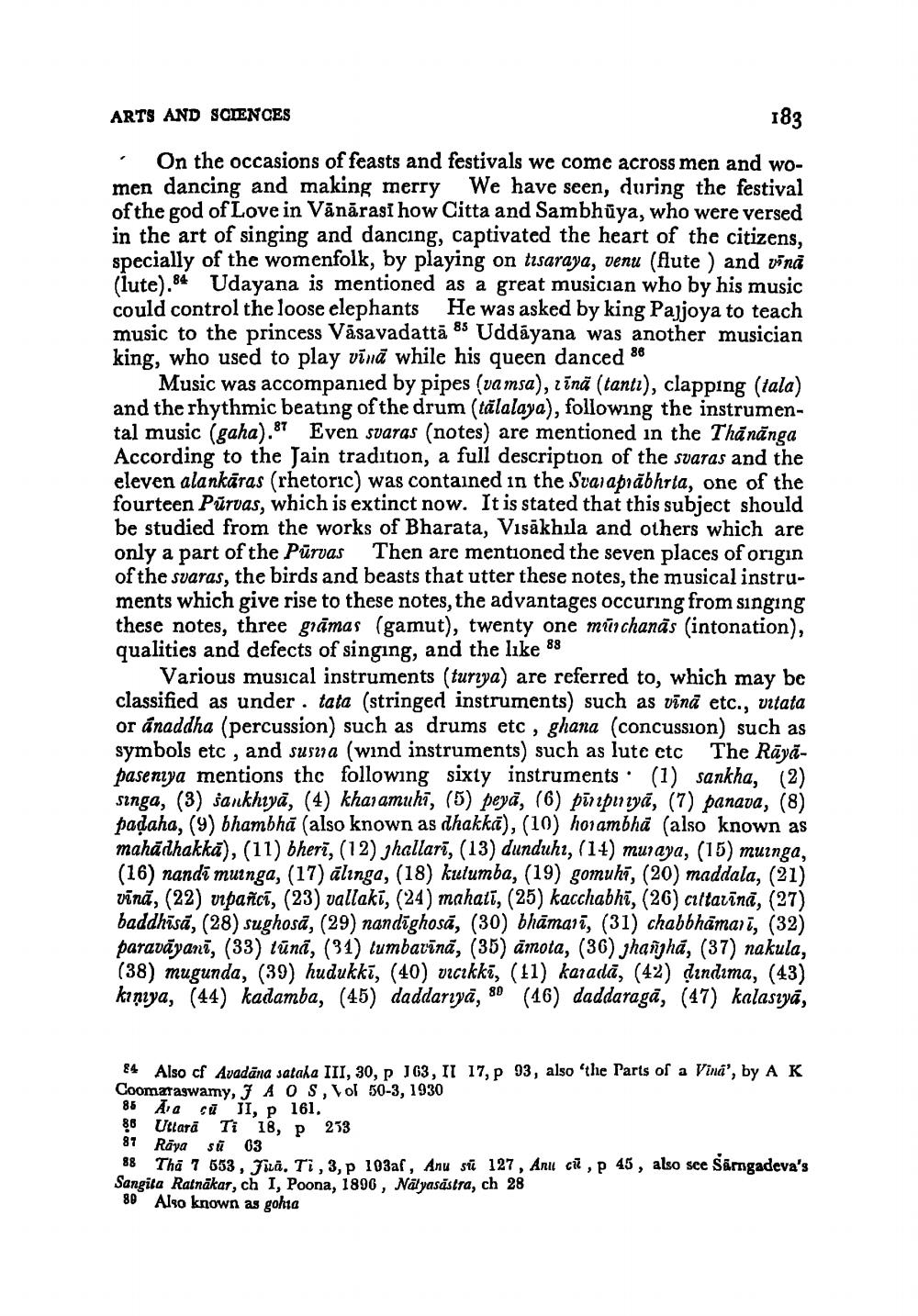________________
ARTS AND SCIENCES
183
. On the occasions of feasts and festivals we come across men and women dancing and making merry We have seen, during the festival of the god of Love in Vānārasi how Citta and Sambhūya, who were versed in the art of singing and dancing, captivated the heart of the citizens, specially of the womenfolk, by playing on trsaraya, venu (flute) and vina (lute).84 Udayana is mentioned as a great musician who by his music could control the loose elephants He was asked by king Pajjoya to teach music to the princess Våsavadattā 85 Uddāyana was another musician king, who used to play vīnā while his queen danced 88
Music was accompanied by pipes (va msa), zīnā (tantı), clapping (tala) and the rhythmic beating of the drum (tālalaya), following the instrumental music (gaha).87 Even svaras (notes) are mentioned in the Thānănga According to the Jain tradition, a full description of the svaras and the eleven alankāras (rhetoric) was contained in the Svarapräbhrta, one of the fourteen Pūrvas, which is extinct now. It is stated that this subject should be studied from the works of Bharata, Visakhila and others which are only a part of the Pūrvas Then are mentioned the seven places of origin of the svaras, the birds and beasts that utter these notes, the musical instruments which give rise to these notes, the advantages occuring from singing these notes, three grāmas (gamut), twenty one marchanās (intonation), qualities and defects of singing, and the like 88
Various musical instruments (turiya) are referred to, which may be classified as under . tata (stringed instruments) such as vīnā etc., vitata or ánaddha (percussion) such as drums etc , ghana (concussion) such as symbols etc , and susza (wind instruments) such as lute etc The Rāyapaseniya mentions the following sixty instruments (1) sankha, (2) singa, (3) sankhyā, (4) khai amuhi, (5) peya, (6) pīripriya, (7) panava, (8) padaha, (9) bhambhā (also known as dhakka), (10) hoiambhā (also known as mahādhakkā), (11) bherī, (12) jhallarī, (13) dunduhi, (14) muraya, (15) muinga, (16) nandi muinga, (17) alınga, (18) kulumba, (19) gomuhi, (20) maddala, (21) vīnā, (22) vipanci, (23) vallaki, (24) mahatī, (25) kacchabhi, (26) cittarīnā, (27) baddhīsā, (28) sughosā, (29) nandīghosā, (30) bhāmaii, (31) chabbhämarī, (32) paravāyanī, (33) tūnā, (31) lumbavīnā, (35) amota, (36) jhanghá, (37) nakula, (38) mugunda, (39) hudukki, (40) vlcikkī, (11) karadā, (42) dindima, (43) kiniya, (44) kadamba, (45) daddarıyā, 80 (46) daddaragā, (47) kalasıyā,
84 Also cf Avadāna sataka III, 30, p 163, II 17, 93, also 'the Parts of a Vina', by A K Coomaraswamy, Í AOS, Vol 50-3, 1930 85 Aa cū JI, p 161. 88 Uttarā Ti 18, p 253 87 Rāya sū 03 88 Tha 7 653, Jia. Ti, 3, p 103af, Anu si 127, Anu ca , p 45, also see Sárgadeva's Sangita Ratnākar,ch I, Poona, 1896, Nälyasästra, ch 28 80 Also known as gohta




